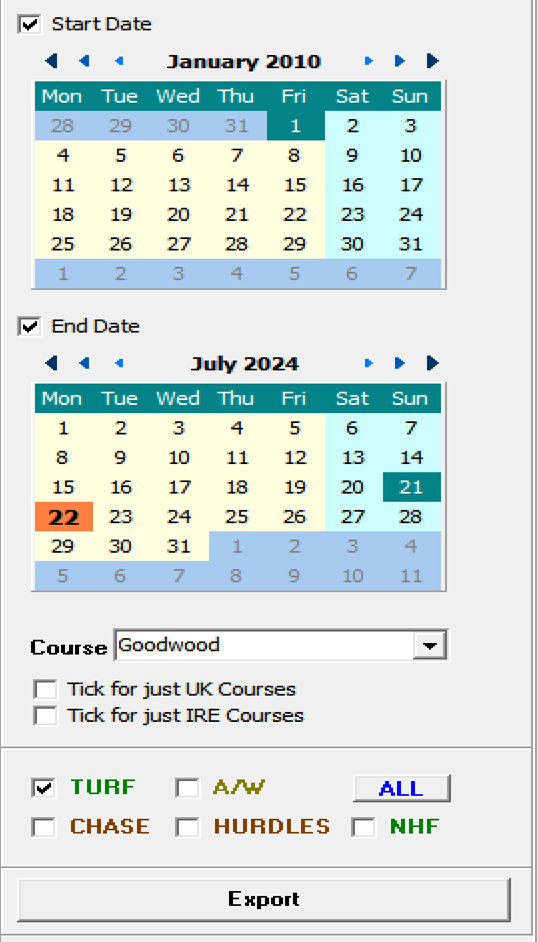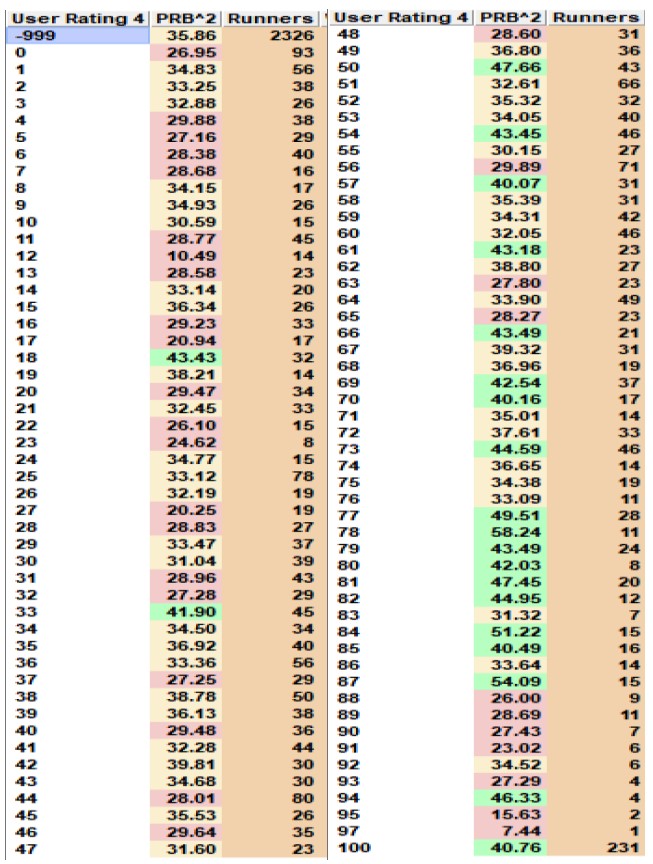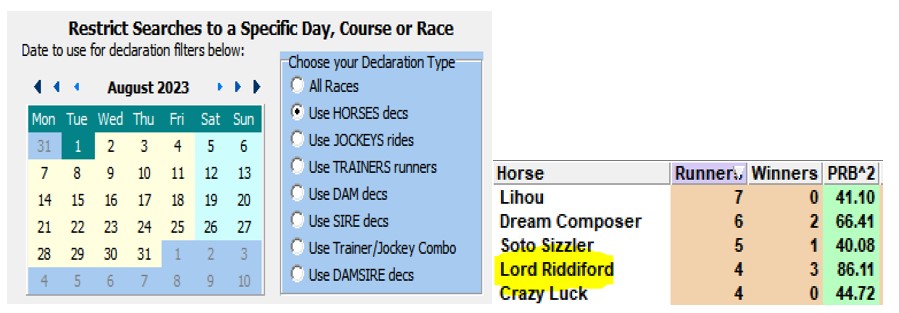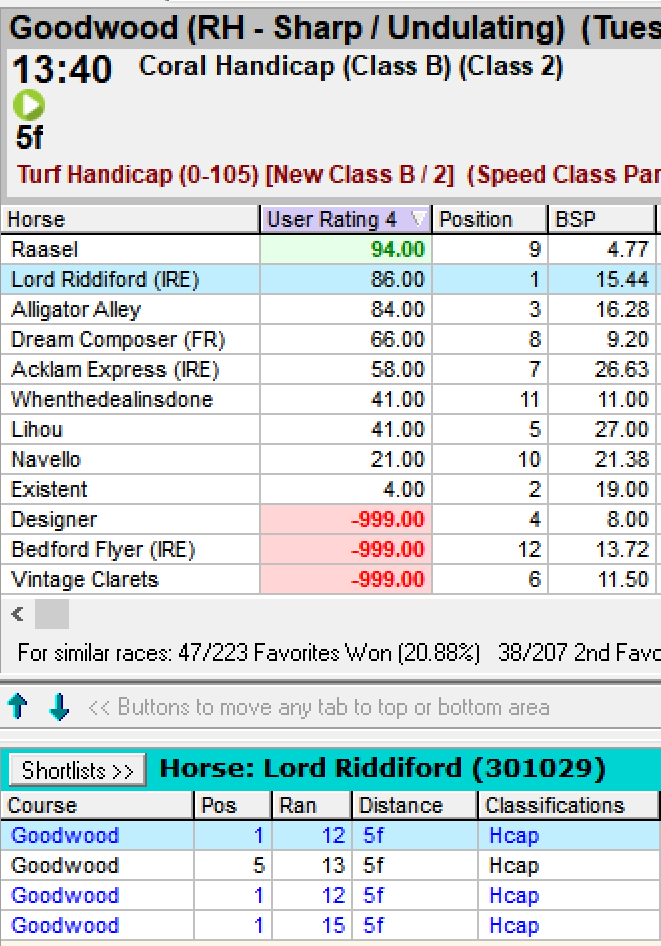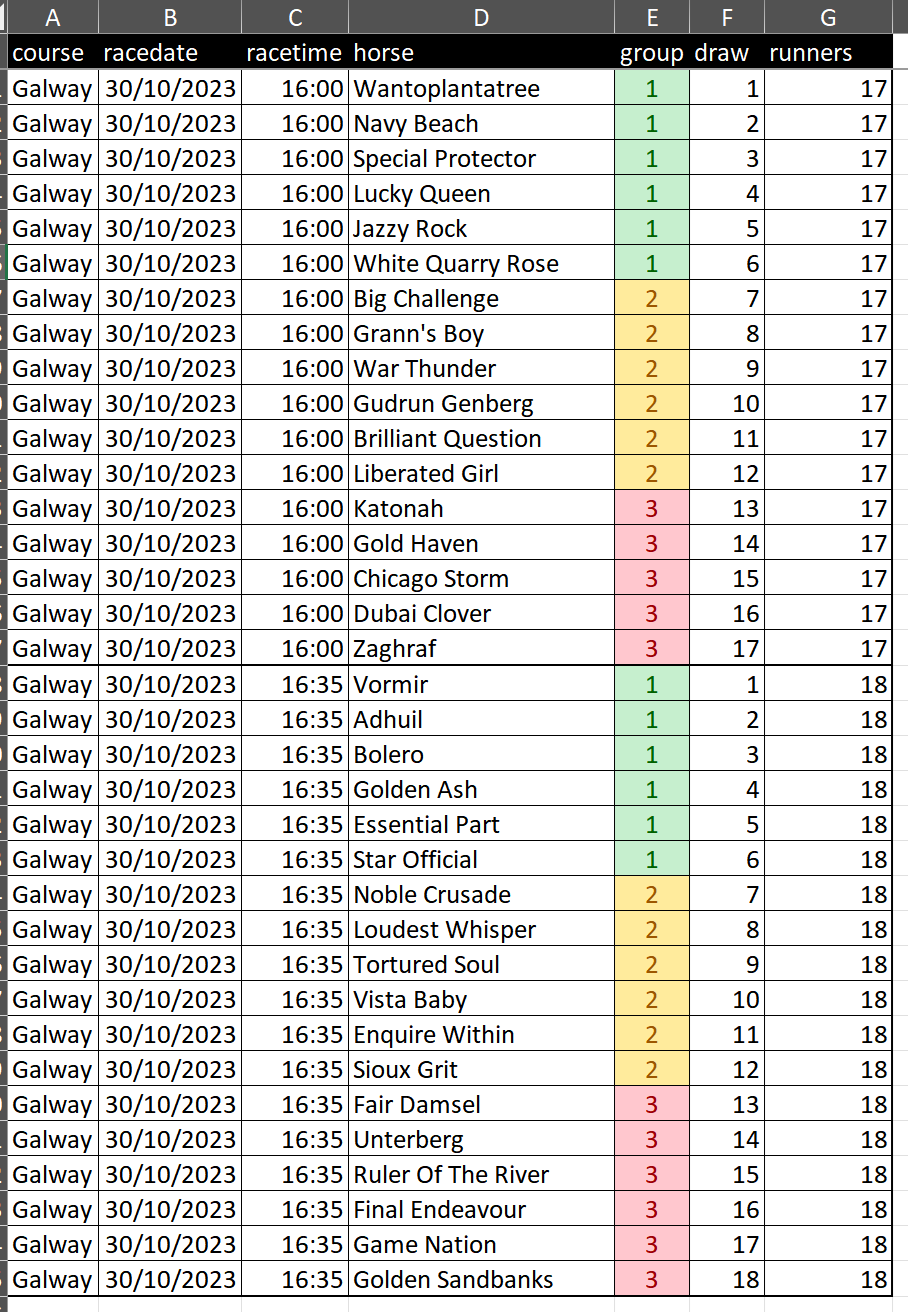Looking Ahead to Galway and Goodwood
July 25th, 2024By Paul Fitzgerald
NOTE: You can click on any image to view in a new window, and you can download a PDF copy of this article on this link
Not long now until Glorious Goodwood and The Galway Festival will be upon us. These two meetings combine over 7 days each summer to produce horseracing to absorb any fan of the sport whatever code or strand of it you follow. Valuable, fiercely competitive jumps and flat handicaps at Galway, maiden races that often feature newcomers destined for the higher echelons at both venues, and the established top-notchers will resume battle at Goodwood, where no less than 13 Group races will be staged next week.
Goodwood is set on rolling downland in a very picturesque part of southern England. Its location topographically gives it a roller-coaster “up and down” profile. The racecourse also features sharp bends, cambers, and over some longer distances, runners will race in opposite directions over the same part of course at the beginning and end of the race, in a switchback fashion. So, all told rather unique.
Credit: Goodwood Racecourse (goodwood.com)
Conventional wisdom tells us that Goodwood’s unique layout makes it tricky in nature and a course that favours horses with experience of having running there before, and or having run well there before. Of course, a “C” (won at course) or “CD” (won at course & distance) beside a runner on any standard racecard would provide evidence of course or course and distance suitability, but what about runners that ran well previously at Goodwood without actually winning? We’d be leaving all of those out if we only considered previous course winners.
In terms of its finishing position a more reflective and granular measure of a horse’s performance can be calculated by the PRB – a term Proform users will be quite familiar with, as it features extensively in the software.
So taking the generally held view that Goodwood’s tricky nature can often favour horses with previous experience of it, I was keen to look at each horses average PRB2 achieved for all previous runs at Goodwood, up to but not including todays performance of course. This would then give a more meaningful measure of whether previous performances at the track were indicative of what horses may produce there in the future. The data required to do this can easily be exported from Proform to an Excel file in a matter of moments. But first a quick explanation of the terms PRB and PRB2
PRB stands for Percentage of Rivals Beaten. The problem with the traditional method of using wins and losses to measure finishing performance - better known as strike rate - is that it makes no discrimination between for example a horse that finishes 2nd in an eleven runner race, and a horse that finishes 11th in the same race. They both receive a zero as they both lost, despite of course the horse that has finished 2nd performing better on the day.
Using Percentage of Rivals Beaten to measure finishing performance in the same theoretical race, the horse that finished 2nd has beaten 9 of his 10 rivals and receives a PRB of 90% or 90, whilst the horse that finished 11th has beaten none of his rivals and receives a PRB of 0% or 0. Hence a more reflective and better measurement of actual finishing performance is achieved. PRB2 simply expands on that concept to provide a smaller reward for positions further away from the winner than PRB does, making it even more reflective of finishing performance again.
So now we can proceed with the Goodwood data export using the Exporter function in the Proform software to get the information from the database that we require.
An example of the exported data is shown below for Hugo Palmer’s, Lovely Breeze, who has run at Goodwood 7 times in her career…
Columns G and H are user generated columns which are used to calculate the PRB2 for each run, as well as the rounded rolling average PRB2 for all previous runs at Goodwood.
The rounded rolling average PRB2 figures for the entire Goodwood file can then be easily imported into the USER RATING 4 column of the Proform database, for further analysis in the software’s system builder.
All Age Handicaps were analysed, as maiden, novice, and handicap races featuring 2yo’s and 3yo’s only, will generally contain fields of lightly raced horses where the majority of runners will not have raced at Goodwood much before, or just as likely perhaps not at all. The same issue arises with the majority of pattern and listed races run at the track.
Starting with the analysis - The par PRB2 for every runner in All Age Handicap’s run at Goodwood between 2014-2023 (10 years) is 35.18
Looking at the returns for User Rating 4 (which is the average PRB2 achieved by runners from their previous runs at Goodwood remember) and using the handy traffic light colouring built into Systems Returns - straight away its becomes apparent that a horses previous average PRB2 at the track can indeed be indictive of its future performance there.
Compiling these User 4 Ratings into an ordered table using the traffic lights for guidance, the returns are as below.
What a horse has achieved in terms of PRB2 in its previous runs at Goodwood, has clearly been a good predictor of what it went on to achieve at the track, certainly in All Age Handicaps anyway. Runners with rolling PRB2 averages of 65 and above, have outperformed the par PRB2 (35.18) and market expectation by some margin.
Every All Age Handicap at Goodwood next week will be either Class B or Class C. These are the highest rated classes in terms of handicaps and will contain better quality horses competing against each other. Here the effect in terms of market expectation as described in the table above becomes even more amplified. Runners for example whose previous visit(s) to Goodwood have returned a lowly PRB2 of between 0 and 30, have performed 23% below market expectation over a solid sample size of 552 runs.
All Age Handicaps – Class B and C
Proform allows users to easily perform analysis such as this, where what at first glance appears to be a complex and difficult to unravel puzzle, can be broken into more easily digestible pieces, initially four pieces or groups in this case. In relation to next week, I would certainly be focusing on shorter priced horses with previous average PRB2 at the track of around 30 or less with a view to taking them on, whilst conversely looking to make a case for runners at around 60 or above. Previous course form can indeed be a useful indicator at Goodwood it seems!
Proform contains all the tools to quicky compile reports for multiple declaration types for any day, meeting or individual race you choose. Below for example, Lord Riddiford’s previous average PRB2 for Goodwood was returned in seconds using the Restrict tool in the system builder.
As a worked example, the opening handicap at Glorious Goodwood last year was indeed won by Lord Riddiford who went into the race with an impressive pre race average course PRB2 of 86. Third and placed in the same race was Alligator Alley whose pre race PRB2 figure for the race was calculated at 84. He had run with merit in the famous and prestigious Molecomb Stakes at the same meeting a few years previously.
Galway Festival
Moving on to Galway and similar to Goodwood, a mainstay of the summer festival there are the numerous flat handicaps - there were 18 of them last year – that are run over the seven days. Again, these will be fiercely competitive, feature large field sizes and often unexposed handicappers. In terms of analysis these races can be complex, and any angles to help break them down is welcome!
Galway is another fairly unusual course in terms of layout – it’s not that big at just 10 furlongs in circumference, its bends are sharp, much of the flat racing particularly at distances of one mile and below is done on the turn, and the home straight is just over a furlong long, so it gives poorly positioned runners very little time to get organised and quicken from off the pace once they turn in for home.
Given that course configuration, and factoring in the high probability of large field sizes, its logical to conclude that draw and early race position must be of some importance in the outcome of races there. I’m sure they probably do exist, but I’ve never seen a draw analysis for the course that entirely satisfied, so I’m keen to have a go at one now.
The first task in this analysis was to export all the Galway draw data from the Proform database into an Excel file. I’ve always been wary of individual stall statistics, as once you’ve broken them down by field size, sample sizes can get small and are prone to variance. Not to mention the vagaries of watering, starting stall locations that may differ from meeting to meeting, track preparation on the all-weather, and so on.
Given that 85% of the flat handicaps run at the Galway Festival since 2010 have featured 12 or more runners I decided that grouping the runners into three by draw would be a sensible starting point.
The Proform data exported into Excel looks as below…For races that divide exactly into 3, such as the 18 runner contest in the 16:35 race, each group will feature 6 runners. Where that is not the case such as the 16:00, the highest group will feature one runner less, giving a 6/6/5 split.
The group numbers denote – 1(LOW DRAW) / 2(MIDDLE DRAW) / 3(HIGH DRAW)
Once each race has been grouped by draw, the file can easily be imported back into any one of Proform’s four User Rating columns. I’ve used User Rating 3 in this case. The groups can then be easily analysed using the Proform System Builder.
In all cases the figures in the tables below are for…
All Galway Turf Handicaps / 12 runners or more / 2014-2023 (10 years)
No real surprises with the low group and high group across all distances. Overall the low drawn group is slightly overbet, the high drawn group is slightly underbet, but take a look at the middle group. A return of -29% to BFSP over a thousand races. Definitely worth taking into consideration in your pre race form study.
Looking at horses that LED in such races
Runners drawn low, that led and who presumably bagged the rail in the process, were still very underwhelming in terms of market return. I’d be looking to take these on (perhaps early in running) if I could spot any chinks in their armour, evidently they are fairly transparent to the market!
Flipping that around and looking at horses that raced in MID-DIV or FURTHER BACK in such races…
This is where those mid drawn horses can really turn into a horror show from a betting point of view. Perhaps they are unintentionally swamped up and shuffled back by high and low drawn runners either side of them, who themselves are attempting to get forward, or intentionally need to be ridden held up. In either case the large fields and short home straight leaves little time or opportunity for extrication from a difficult position. You really need to have a very strong case for your selection if your backing a mid-drawn hold up horse at Galway on all evidence here.
The analysis undertaken here is of course for all distances. The Proform user can break these draw groups down even further, and look at performances by draw group for individual race distances too. To assist with the task of predicting the position of where your potential selection may race, Proform also provides paceform lines, as well as pace ratings and pace rankings for every runner in every race, every day.
Some other interesting angles for Galway…
Handicap Chases
The entire week at Galway only features three handicap chases, as opposed to nine handicap hurdles, so opportunities are limited in this sphere. In addition, all three handicap chases are valuable in terms of prize money, indeed The Galway Plate Handicap Chase is the feature race of the festival. Its logical to think these races will be targeted by trainers with perhaps unexposed chasers, lightly raced over the larger obstacles, open to improvement and allotted handicap marks that may not yet be an accurate reflection of their true ability.
Taking a look at the previous number of handicap chases contested horses with only one or two handicap chase runs in their career to date have performed very well against market expectation…
Jockeys
Moving on to jockeys and perhaps a simple one, but in terms of sheer returns, Patrick Mullins is not one you could possibly ignore. His Galway Festival record is simply outstanding. The fact of that alone means all his mounts must merit close inspection, particularly as his regular source of firepower for this meeting, his Dad, will presumably be an able provider again this year.
Maiden Races
The Dermot Weld / Galway Festival angle is as old as Methuselah, but given Galway features no less than 9 maiden races over the flat for the week, I was interested to see how the bigger trainers performed, given their runners in these contests won’t go short of media or market attention too often. Franky their returns are dreadful, losses in nine of the last ten years when you combine the returns in Maiden races for the runners of, A P O'Brien, D K Weld, G M Lyons, J S Bolger, John Joseph Murphy, Joseph Patrick O'Brien, Mrs John Harrington. Focusing on runners who have displayed the requisite ability to win one of these races, and who are trained away from the seven stables listed above, may well prove to be value entry into these races.
I will post the import files containing all the Goodwood PRB data, as well as the Galway draw groups, on the Proform members group, so users can start their own analysis of these angles if they so wish. Best of luck and enjoy what should be a week of great racing.
By Paul Fitzgerald
Age 53. Live in County Clare, Ireland.
Followed racing most of my life since watching Red Rum win the 1977 Grand National.
Prefer flat racing.
Been with Proform for more years than I care to remember at this stage, so pretty familiar with the software and its functionality.
Mainly data-based approach to racing. Build my own models, which I combine to calculate a base probability. Adjust that base probability with my own subjective opinion to form a final price, which I then take to the market.
Use Betfair only.
*Proform Telegram Members Group
Proform Subscribers can join the Telegram group chat for which can be used for support, systems
ideas, sharing selections and much more.
If you would like to join, then send me a message on Telegram with your name and your
Proform login email address and we will add you to the group chat.
My telegram username is @proformracing
You can download Telegram on your mobile from here https://telegram.org/
and there is also a desktop version you can install on your computer.
NOTE:
You need to open Telegram on your mobile.
Click on the 3 lines in the top left corner of the screen.
Click on Contacts.
Enter Simon Walton or my telegram name which is @proformracing into the name’s fields and my mobile number 07984 648774.
You should then be able to contact me and give me your full name so we can see that you are a
subscriber and then we can add you to the group




